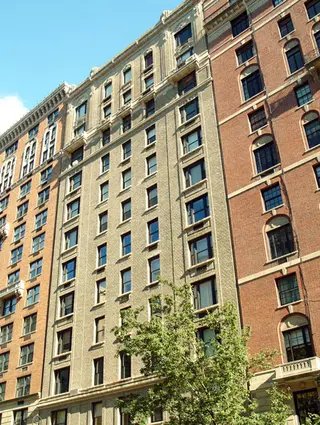 Carter Horsley
Carter HorsleyDec 23, 2011
Carter's Review
Erected in 1912, this 13-story, mid-block building at 565 Park Avenue between 62nd and 63rd street was converted to a cooperative in 1962. It has 31 apartments.
It was designed by Robert T. Lyons for Bing & Bing and replaced two smaller apartment houses. Lyons was the architect also of the apartment buildings at 955, 993 and 1155 Park Avenue and the St. Urban on Central Park West and was an associate architect of the Chrysler Building.
Bottom Line
This pleasant, mid-block building has some interesting layouts and a prime Park Avenue location.
Description
The attractive light-beige brick structure has a one-story limestone base and a two-story entrance surround.
There is a bandcourse above the third story and a string course above the 10th floor and a bandcourse with balconies on the 11th floor. The 12th floor windows have decorative lunettes and the roof life has four small crowns.
This building, which has inconsistent fenestration and protruding air-conditioners, is located in a very attractive section of Park Avenue that is convenient to midtown, many churches and clubs, fashionable boutiques and restaurants along Madison Avenue, Central Park and public transportation.
Amenities
The building has a doorman and a live-in superintendent.
Pets are allowed.
Apartments
PenthouseA12E is a one-bedroom duplex that has a 19-foot-long living room that opens onto a 16-foot-long library around a staircase and also leads to a 17-foot-long dining room next to a 13-foot-long kitchen and maid’s room on the lower level and a 19-foot-long den with a 19-foot-long terrace and 22-foot-long dressing area next to the master bedroom on the upper level.
Apartment 11E is a two-bedroom unit that has a long foyer that leads to a 21-foot-long living room next to a 19-foot-long dining room off the 12-foot-long kitchen and a 9-foot-long office.
Apartment 2E is a two-bedroom unit that has a long foyer that leads past a 17-foot-long kitchen to a 20-foot-long living room next to a 12-foot-long den/dining room and a 13-foot-staff room.
Apartment 6E is a one-bedroom unit that has a long foyer that leads past a 12-foot-long kitchen and 9-foot-long breakfast room to a 21-foot-long living room that opens onto a 19-foot-long dining room in one direction and leads to a 14-foot-long library in another.
Apartment 3W is a three-bedroom unit that has a long entry foyer that leads to a 22-foot-long living room that opens onto a 19-foot-long dining alcove next to a 12-foot-long kitchen. The unit has two maids’ rooms.
History
Bing & Bing was one of the city's most important developers of apartment buildings in the first few decades of the 20th Century. Leo S. and Alexander M. Bing were "widely read, cultured, fastidious, and intelligent young lawyers" who "exuded a quiet confidence and favored a conservative appearance," according to Tom Shactman, the author of "Skyscraper Dreams, The Great Real Estate Dynasties of New York," (Little, Brown and Company, 1991).
"Under their three-piece suits with high collars, the brothers concealed progressive sentiments. Alexander was much taken with the City and Suburban Homes model for development. Using their legal knowledge, the Bings formed a syndicate of investors to buy land along Broadway near intersections where subway or elevated lines were being constructed, resell the plots to builders, then provide them with loans for construction.
“During the [first World] war, Alexander Bing had been a housing consultant to two government agencies. He dreamed of following the path of the limited return City and Suburban Homes Company and became the spearhead of the City Housing Corporation, which produced a sprawling complex of one- and two-family homes and apartments in Sunnyside, Queens.
“Leo Bing split with Alexander in this era because he had a different objective: housing for profit." "'That is good architecture,' Leo told [architect Emery] Roth, 'which people are willing to pay for. To erect a building, however well it conforms to the standards of design, that does not produce the maximum of income is, to that degree, poor architecture.'
“Every year, Roth would design a building or two (or sometimes three) for Bing & Bing, now Leo's company, in every district from Greenwich Village to Washington Heights, from simple dwellings to palatial hotels and apartment houses," Shactman wrote.
The hotels would include the Dorset on East 54th Street, which will be demolished for an expansion of the Museum of Modern Art, the Drake on Park Avenue and the Alden on Central Park West. Leo Bing also employed Philip Birnbaum for nine years as on-site inspector and Birnbaum would go on to his own architecture practice in which he became probably the most prolific designer of high-rise apartment buildings in the city.

- Co-op built in 1912
- 2 apartments currently for sale ($1.695M to $3.985M)
- Located in Park/Fifth Ave. to 79th St.
- 28 total apartments 28 total apartments
- 10 recent sales ($1.1M to $4.7M)
- Doorman
- Pets Allowed

 6sqft delivers the latest on real estate, architecture, and design, straight from New York City.
6sqft delivers the latest on real estate, architecture, and design, straight from New York City.
